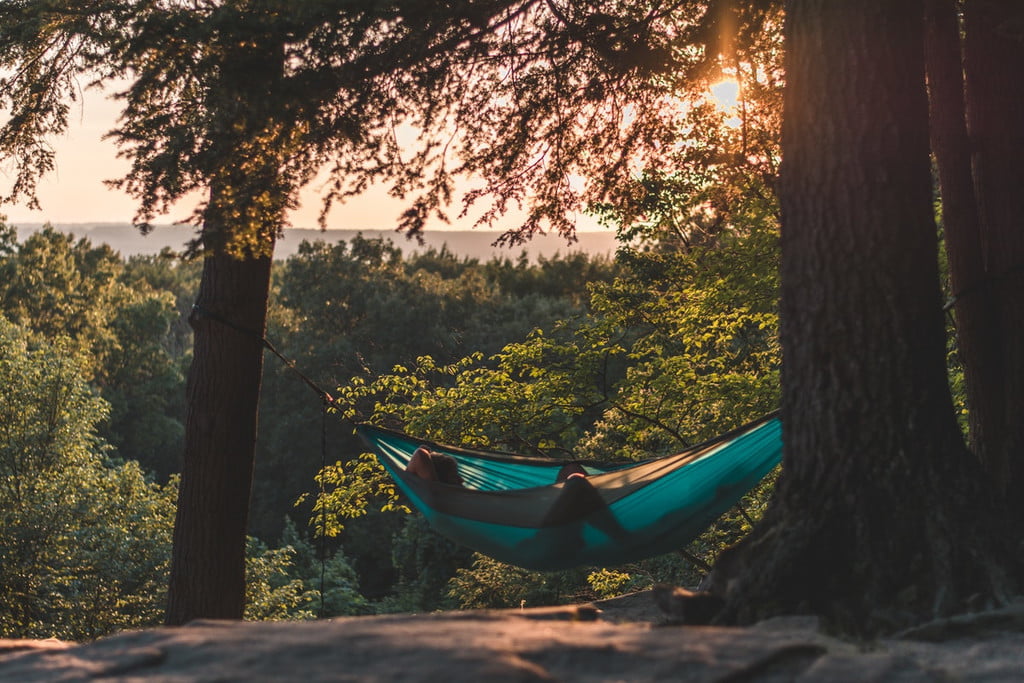
Any camper who has spent the night tossing and turning on the cold, hard ground has at some point wished there was a better alternative. Sadly, for some, the answer is to never go camping or try out tent or hammock camping. Others spend time searching for the perfect sleeping pad, air mattress, cot, or other system that promises a better night’s sleep. The latest trend, although it’s not a new idea, is to forego the ground altogether and sleep in a hammock.
The radical but simple idea of sleeping in a sling suspended between two trees has been around for a long, long time. One of Christopher Columbus’ first observations in October of 1492 was the Taino people’s practice of sleeping in “nets.” European sailors adopted the practice to replace their mattresses stuffed with leaves, straw, or horsehair and discovered a better night’s sleep with less clutter aboard their ships. Modern ultralight adventurers have rediscovered this age-old creature comfort, and for good reason.
Convenient and comfortable
Lately, there has been a spike in hammock camping, especially among adventure travelers. Backpackers and bike-packers appreciate sleeping in a sling because the equipment is so much lighter and more compact than a traditional tent and sleeping pad. The camping hammock tent is easy to store in a pack. Setup is fast and easy wherever there are two suitable trees. Plus, hammocks support the Leave No Trace ethic that backcountry visitors are encouraged to adopt.
It may seem like the long curve of a hammock would bend the spine at an uncomfortable angle. Indeed, it would if someone were to align their body down the center of the hammock. The key to sleeping comfort is in the so-called “hammock angle.” Imagine lying on top of a straight line that runs parallel to your spine. Then, move your feet to the left about 8 inches, and move your head and torso to the right about 8 inches, so that your body is positioned on a 30-degree diagonal to the center line. That’s the key to flattening the curve in a hammock and getting a great night’s sleep.

Less gear, less weight.
When you go camping, staying dry, bug-free, and comfortable are the keys to a great night’s sleep. Three pieces of essential gear, and one optional piece, make that happen. In addition to the hammock, you’ll need a rain fly and bug net. You could buy each part separately or choose a kit like the Buy at Hennessy Hammock .
In cold weather, the fourth piece becomes necessary. Lots of campers sleep comfortably in freezing temperatures by adding an insulating Buy at Amazon to keep out the cold. It attaches to the outside of the hammock to trap body heat inside without losing loft to compression.
There are more benefits of camping in a hammock
Hammocks only require two existing trees for a secure, comfortable camp. Easy-to-use strap and carabiner systems almost eliminate the need for knots. Setup is easy, fast, and secure. Other lightweight and ultralight shelter systems involve poles, sleeves, or other gear that can be lost or broken, and many of them are much less spacious than a hammock.
If it rains on a tent, it sheds water onto the adjacent ground. But you’re sleeping on the ground, so it increases your chance of getting wet in the middle of the night. Or, if you accidentally set up in a low area, your whole campsite could get flooded. Not so in a hammock since you’re suspended above the ground. Just be sure to use drip lines (more on those later).

Set up quickly, stay dry
Set up in this order. When precipitation threatens, hang the rain fly first. Then, when your equipment is sheltered, assemble the hammock, bug netting, quilt, and other equipment. You may get wet in the process, but your sleeping bag and other gear will stay dry.
Use drip lines. The lines on a hammock lead downhill to your sleeping area. In rainy weather, water will follow the lines to soak you, your sleeping bag, and the rest of your stuff. Tie short pieces of paracord to the suspension lines at each end of the hammock to interrupt the flow. They will draw the rainwater downward to drip harmlessly on the ground.
Avoid over-tightening the lines. Rather than pulling the straps as tightly as a guitar string, let the hammock sag just a bit. Doing so allows the sides to relax so that you can lie on the diagonal and use more of the width. Plus, the sides won’t wrap you up like a burrito. Add some cushioning. A hammock is more comfortable than the ground, but if you add a sleeping pad and pillow, it can come close to feeling like lying in bed at home.
With the proper setup, a hammock can help you get to sleep faster, sleep more deeply, and wake up without the body pains common in tent camping. What could it hurt? Give it a try — your back will thank you!





